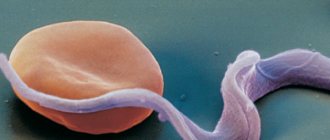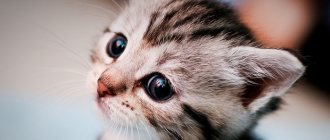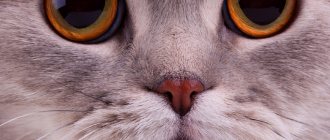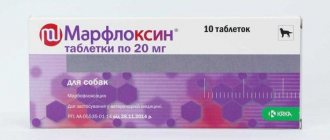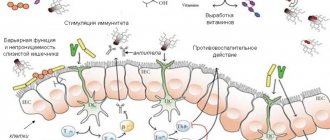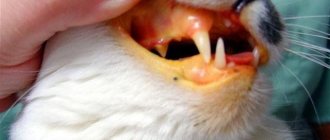Who are Giardia?
It is not a worm, bacteria or virus. Giardia (Giardia) is a single-celled protozoan flagellated microorganism, one of the most common parasites of various animal species (cats, dogs, rodents) and birds.
Man is also on their list. Giardia has two nuclei and two sets of organelles - four pairs of flagella, two medial bodies - everything for simple reproduction by longitudinal division in half, which is what they do. By the way, in the picture these are not eyes, but just nuclei
The body of Giardia is pear-shaped - the front part is rounded and widened, the back part is pointed. The main feature of Giardia is the suction disk on the lower surface of the body. With its help, it attaches to the microvilli of the small intestine and begins to lead a parasitic lifestyle, feeding on the digested food of the host. This is the trophoziod (vegetative stage) of Giardia. It is this form that is invasive, pathogenic, and capable of reproduction. It is very sensitive to external conditions and dies immediately when they change.
Therefore, Giardia also has a second form of existence - cysts . This temporary form is characterized by a protective shell (the microorganism “pupates,” as it were), making it more resistant to adverse factors. Giardia cysts are resistant to low temperatures, but die instantly when boiled. Cysts love moisture; drying them in air for 24 hours leads to complete death. They can live in soil and water for several months. Cysts are resistant to ultraviolet radiation and chlorine.
It is the “cyst” form that serves to “transport” the parasite. Giardia, entering the large intestine from the small intestine, turns from trophosioda into cysts and is excreted along with feces.
Both forms enter the external environment, but only cysts survive!
What it is?
Giardia is the name given to microorganisms that parasitize the small intestine not only in cats, but also in many other animals. Carriers of these protozoa can be rodents, birds, dogs and even humans.
With the help of a special suction disk located on the abdomen, Giardia attaches to the intestinal mucosa and multiplies, feeding heavily on the digested food of the host. Traveling through the intestines in two forms - trophozoid (a form of Giardia that is capable of reproduction) and a cyst (a stable form with a shell, like the “pupa” of butterflies), the parasites can live in the cat’s body, as well as in soil and water, for many months.
These Giardia are very tenacious: they do not die during the day under the influence of UV rays, and they are not damaged by disinfection of the room with chlorine. Only a decrease in humidity can destroy these creatures. They leave the cat's body along with feces, which is extremely dangerous, since the owner often becomes infected with giardiasis.
How does giardiasis become infected?
It’s very simple - by the fecal-oral method (through contaminated water or food, through washing and licking the cat’s paws after visiting the tray, which was also used by the sick animal).
A cat becomes infected with giardiasis after ingesting cysts of the parasite. Stomach acid weakens their membrane, and once in the intestine, the cysts are converted back into trophozoids. This active form attaches to the intestinal wall and begins to feed and reproduce by division. When a sufficient number of Giardia accumulates, clinical signs of infection appear.
Symptoms of the disease
Since parasites are characterized by microscopic sizes, the negative impact continues until there is a lot of Giardia. Only then will there be signs of their presence. As a result, the disease develops rapidly, and treatment is prescribed later than necessary. The intensity of the manifestations also varies greatly, which is influenced by the age, weight and health of the pet at the time of infection.
Main symptoms: sometimes vomiting occurs, the animal becomes lethargic and inactive
Clinical signs of the presence of Giardia in cats:
- General body weakness
- Intestinal disorder, with soft stools; as the disease progresses, the stool becomes watery and its color changes (yellow, green)
- Blood is released along with the feces: at first these are small inclusions, gradually the amount increases
- The smell of feces is specific
- The quality of the coat deteriorates, the skin becomes dry
- As a result of intoxication of the body with waste products of Giardia, an allergy develops.
Sometimes vomiting occurs. In general, the animal becomes lethargic and inactive. Against the background of clinical symptoms, weight decreases, but the cat’s appetite does not decrease.
Why is giardiasis dangerous?
Giardia, clinging to the intestinal walls, irritate its epithelial layer, disrupt secretory and motor functions, and interfere with the absorption of fats, carbohydrates and other substances.
By forcing the body to absorb the products of its vital activity, parasites cause toxic-allergic reactions. With an increase in the number of Giardia, the intestinal wall is gradually traumatized with the formation of microerosions with the presence of inflammation. This provokes a malabsorption of proteins, glucose, fats and fat-soluble substances, which in turn leads to vitamin deficiency, the development of dysbacteriosis and the appearance of diarrhea.
Sometimes, due to mechanical blockage of the pancreatic and liver ducts, pancreatitis occurs.
The accumulation of Giardia will aggravate the situation.
The danger of giardiasis in cats
Giardia in a cat irritates the intestinal mucosa, disrupts the secretion function, and slows down all motor processes in the animal’s gastrointestinal tract. In addition, these parasites interfere with the absorption of beneficial substances, forcing your pet’s body to absorb not the necessary vitamins and microelements, but the products of its vital activity. They cause allergies and intoxication in the animal.
Treatment of giardiasis in cats should begin as soon as the first signs of a change in the animal’s well-being appear. After all, the accumulation of Giardia injures the walls of the stomach and leads to ulcers and erosions. A pet can acquire chronic pancreatitis, develop vitamin deficiency and dysbacteriosis, or even die from dehydration, since diarrhea with giardiasis constantly makes itself felt.
Symptoms of giardiasis
Due to the small size of the parasites, symptoms may not appear immediately, but only appear when the Giardia itself and its toxic products become too numerous.
The severity of giardiasis and the range of its symptoms may vary from cat to cat. This depends on the infecting dose, the age of the animal (young people get sick more often), the state of the intestinal microflora, the presence of other diseases, the stability of the immune system in general, social factors, etc.
Of course, those at risk are walking cats and cats living in crowded conditions (kennels, shelters), animals with diseases of the immune system.
Symptoms of giardiasis may be subtle and manifest as minor intestinal disorders or general malaise. Sometimes it occurs without clinical signs.
Giardia can cause chronic diarrhea in cats. The animal's appetite usually does not change, and the weight decreases.
Stools can range from soft to watery, have a pale yellowish or greenish tint, have a foul odor, and sometimes contain blood or mucus. Diarrhea may be intermittent.
With a long course of the disease, the cat may have a deficiency of fat and other vitamins, which leads to dry skin and brittle hair.
Due to poisoning of the body with the products of parasite secretions, the animal may experience various types of allergic reactions.
In some cases, there is vomiting and a decrease in general activity.
Prevention
Giardia cysts live for a long time in the outdoor environment and are extremely contagious. In areas where cats interact, the risk of infestation is high. Therefore, preventing infection consists of observing hygiene requirements. The tray must be washed regularly, disinfecting with boiling water. The Fellinologist is required to wash his hands after cleaning the toilet, as well as bowls. Maintaining the cat's immune system at the proper level is of great importance. This means that it is necessary to use complete factory-prepared feed. Regularly carry out disinsection, vaccination, and deworming. Drugs that eliminate worms also kill Giardia.
We invite you to join our Zen channel and group on VKontakte or Odnoklassniki, where new articles for pet owners are published.
Similar articles:
- If your cat has food allergies
- Ringworm Caution: What Pet Owners Need to Know
- Why are cats overweight?
Diagnosis of giardiasis
Giardiasis is confirmed by the presence of cysts or trophozoids of the parasite in the feces. Since Giardia does not come out with every portion of feces and in small quantities, it is necessary to study samples over several days. For stool analysis, the flotation (separation) method and/or the fecal smear method are used.
To detect Giardia, there are also special tests - enzyme-linked immunosorbent assay (ELISA), immunochromatographic test (IC), which allow you to quickly and reliably make a diagnosis. But the most accurate diagnostic method is polymerase chain reaction (PCR).
How to detect parasites?
In addition to the symptomatic component, when making a diagnosis, the veterinarian uses a special analysis - submitting stool or fecal smear for the content of protozoa, including Giardia. Giardia cysts or trophozoids do not always leave the cat’s body, so this analysis is done over several days, each time processing the samples under a microscope.
Since the treatment of Giardia in cats and dogs is quite popular, a special test was invented to detect only these parasites in the animal’s body - enzyme-linked immunosorbent assay (ELISA) or immunochromatographic test (IC). It is done in any veterinary clinic or laboratory.
Treatment of giardiasis
Giardiasis can be treated, but the fight against it must be carried out in a timely and competent manner. Therefore, when your pet develops symptoms, we go to the doctor!
Giardia are parasites, and they are expelled by antiparasitic drugs. Simple anthelmintic drugs will not help here; an antibiotic is required.
The most commonly used is metronidazole, less commonly tinidazole and furazolidone, or a combination thereof.
Together with them, enterosorbents (to remove toxins) and probiotics (to improve intestinal microflora) are prescribed, and a special diet is also desirable.
The usual course of treatment is 7-10 days. To ensure the effectiveness of treatment, repeat tests are done.
Giardia in cats is more resistant to treatment than, for example, in dogs. Therefore, sometimes several courses of treatment or replacement of drugs are required.
The journal “Veterinary Focus” (2009, No. 19.1) describes a case where, based on test results, a cat was confidently diagnosed with giardiasis and treated with metronidazole. At first the severity of the diarrhea decreased, but 10 days after treatment the condition worsened again. It turned out that the free-roaming cat sometimes played in the yard with the kitten. Both cats were additionally treated with fenbendazole, bathed and dried (to exclude the presence of cysts in the fur), litter trays and cat walking areas were disinfected. Only after this the symptoms disappeared, fecal tests (including repeated tests three weeks later) gave a negative result, and there were no further complaints.
Can you get infected from a cat?
Giardia cati is Giardia in cats, belonging to a separate biological species, different from the single-celled ones characteristic of the human form of the disease. The overwhelming majority of protozoa that parasitize the body of cats are not dangerous to humans, but there are common types of pathogens that can infect people. In medical practice, cases of human infection with giardiasis due to close contact with animals have been recorded. Finding a cat without pathology is difficult; even a newborn kitten can have giardiasis or coccidiosis transmitted by a sick mother. Pets are natural carriers of parasitic diseases, so old people, children, and people with weak immune systems should especially stay away from sick animals.
Giardia in a cat: methods of infection
Following good hygiene and nutrition will help prevent illness or reduce the risk of complications.
- It is better not to let a domestic cat outside.
- For feeding you need to set aside a special place. Food should only be placed in a bowl (not thrown on the floor), which should be periodically doused with boiling water.
- There is no need to ignore preventive vaccinations.
- After going to the toilet, the cat must be washed so that no cysts remain on the fur.
- The tray must be kept clean. Street sand cannot be used as a filler.
- If there are other pets in the house, they must be isolated.
Intestinal obstruction in cats: symptoms and treatment
Giardia is characterized by a double set of chromosomes and two cell nuclei. In shape they resemble a drop with flagella. The rounded part is the front of the cell and has a suction disc at the bottom. Thanks to this device, it quietly adheres to the intestinal walls and begins its parasitic life. With the help of villi, it absorbs the digested food of the host.
Giardia species
Infection occurs through the oral route. Cysts enter the oral cavity through contaminated food or water. Another way is infection through the feces of an already sick animal. Perhaps the cat shares the same tray with an already sick pet.
The cat drinks from a puddle
There are preventive measures that will help prevent giardiasis in cats:
- maintaining hygiene. It is better to use chlorine bleach to protect the environment. Cat bowls need to be washed under boiling water, and your pet’s favorite places are also treated;
- you need to monitor water quality. When waste gets into water bodies, there is a risk of Giardia infection. Keeping water clean is key to animal health;
- if the cat eats fruits or vegetables, they need to be washed;
- It is better to identify the symptoms of the disease as early as possible, so it is necessary to monitor the cat’s condition.
Monitoring your pet's well-being
So, if there is a suspicion that a cat has Giardia, the symptoms and treatment should be assessed by a doctor. Perhaps the assumptions about the disease will be incorrect and money on antibiotics will be wasted. Your pet should be examined at a veterinary clinic.
The rules of behavior that allow you to protect yourself from infection with helminths and other parasites are not so complicated. You just need to keep clean, regularly wash your hands with soap, rinse vegetables and fruits under running water, do not use other people’s things, and do not play with stray animals. That is, to do what parasitologists never tire of advising us. And then the risk of contracting giardiasis will be minimized.
However, despite the simplicity of these rules, it seems that not everyone follows them. The scale of giardiasis infection is enormous. WHO has information that about 500 million people are infected every year around the world. In Russia, for every 100 thousand people, 90 people become infected. For children under 14 years of age, this figure is even higher – 350.
Transmission routes
Many people know that infestation most often occurs when eating food and water contaminated with parasites.
Giardiasis is an infectious disease. This means that it can be contracted by coming into contact with other people. If one family member is diagnosed with Giardia, quite often other members of the household also become ill with it. Children are most often infected with parasites. Which is understandable. Their compliance with the rules of personal hygiene is a problem known to all parents.
Routes of infection
Infection occurs through food, shared objects, and ordinary physical contact, such as shaking hands.
The described type of helminthiasis is transmitted from one person to another when its pathogens are in the form of eggs called cysts. Unlike adult individuals, cysts have increased resistance to adverse external conditions. And therefore, being released into the external environment, they remain viable for some time - depending on the conditions existing in this environment - and can cause invasion.
Young children who have an irresistible tendency to taste all objects are especially susceptible to infection. The habit of biting nails also contributes to Giardia infestation. In places where children are in large numbers - in nurseries, kindergartens - infection is always high, despite all the measures taken to maintain cleanliness
The transmission of parasites from infected to healthy people occurs both regularly and periodically. A study of giardiasis made it possible to establish that the release of cysts on a regular basis occurs in 4.7% of infected people, while on an irregular basis - in 95%.
Prevention
Giardiasis is not without reason called the “disease of dirty hands,” thereby implying that the main cause of infection is lack of personal hygiene.
We suggest you read: Why cats purr versions of experienced breeders
The easiest way to protect yourself from parasite infestation is to maintain basic cleanliness. Boil food well. Those that are taken raw - vegetables, fruits, berries - should be washed with running tap water. Which, by the way, must be filtered, since the reservoir from which it is taken may contain Giardia eggs.
There is a high risk of infection with Giardia in families in which one member has been infected. In this case, all objects that he uses become a potential source of infection. If one family member is infected, everyone else is recommended to take preventive measures against the disease, which includes taking antiparasitic drugs.
Certain behavior patterns of people of certain groups also contribute to infection. Since cysts enter the body through the mouth, gay men are among the people at increased risk of infection.
Infection with Giardia in humans from cats and dogs has not been established with complete certainty. However, it is reliably known that animals are susceptible to giardiasis. Therefore, the possibility of transmission of cysts from an animal is beyond doubt.
The routes of infection for an animal are essentially the same as for humans. Invasion can occur through food, water, and various objects. Not to mention that while walking, the dog may be faced with the possibility of infection at every step. It has been established that pathogenic bacteria and parasites transmitted from cats and dogs include:
- salmonella bacteria;
- worms;
- Giardia.
Most often, infection occurs through contact with an animal, feeding, petting, or playing. This does not mean that you need to completely eliminate contact with homeless people or pets. Sometimes it is very difficult to deny ourselves the desire to caress our little brothers. You just need to make it a rule to wash your hands with soap after close contact with them. As a result of this simple procedure, parasite eggs, if they get on your hands, will be washed off.
Giardia from cats is transmitted to humans in the same way as from a dog. Giardiasis in felines is not such a rare disease. Considering that it, especially in the initial stages, can be asymptomatic, we may not even suspect that our pets are suffering from parasites.
It is possible to determine the presence of the disease in pets without testing using indirect signs. For example, if they eat normally, they lose weight and their excrement does not look like what it should look like in a healthy animal. If you have frequent or persistent diarrhea, this is a good reason to get your pet checked.
And of course, you cannot refuse help to animals if they are infected with giardiasis. We need to help them get rid of parasites, from which they, just like people, experience discomfort and are at risk of complications. If there is any suspicion of infestation in animals, it is necessary to show them to a veterinarian.
It is also necessary to treat animals infected with giardiasis because they become potentially dangerous not only to other pets, but also to all family members. If it is definitely established that the animal is suffering from giardiasis, it is necessary to take preventive measures, which may include reducing communication with the animal, increased hygiene measures, as well as preventive administration of anthelmintic medications.
On the one hand, the transfer of cysts from one person to another during a kiss is quite possible, since they can be in the saliva of an infected person. But at the same time, according to experts, this is possible only in extremely rare cases, with an unfortunate combination of many circumstances. The most common type of Giardia infestation is still the usual household contact method.
But even if it were different, and the transmission of infection through a kiss were not exceptional, but commonplace, it is unlikely that this would make people give up expressing their love with kisses.
Conclusion
Giardiasis is not a disease with a poor prognosis. But it is dangerous enough to cause significant harm to the body and reduce its functionality. Giardia damage to the small and large intestines and a decrease in the digestive function of the gastrointestinal tract weakens the body, making it weak against other diseases.
To reduce the risk of giardiasis to a minimum, you just need to follow a number of simple rules. Wash your hands often, do not drink unfiltered and unboiled water, eat only fresh, properly prepared food, wash fruits and vegetables thoroughly, do not use other people’s things, do not play with stray animals.
Giardia enters the body of cats in the form of an inactive form of parasites called cysts. When cysts enter the intestines, the aggressive environment destroys their outer shell. This allows Giardia in cats and cats to move from the form of cysts to the active phase of development in the form of trophozoites. In this form of development, Giardia in animals begins to feed and reproduce in the intestines, causing harm to the body with the products of their vital activity.
Preventive measures
Since Giardia can survive in the environment for a long time, the main preventive method against them is maintaining cleanliness in the house and normal hygiene rules, which consist of the following actions:
- washing hands after cleaning the tray;
- timely disinfection of all surfaces in the house;
- high-quality cleaning of cat habitats;
- treating the cat's tray and dishes with boiling water.
We suggest you read: Is it possible to give cats Aspirin? What painkillers can be given to cats? Is it possible to give a cat aspirin for fever?
Giardia is very susceptible to a dry external environment, so excessive humidity should not be allowed in the house. In order to avoid infecting your pet with giardiasis, it is necessary to minimize his visits to places where animals frequently gather.
Giardia, which infects humans and cats, belongs to different species, but scientists do not exclude the possibility of humans being affected by Giardia in animals. For this reason, owners of cats with giardiasis should be even more careful about following hygiene rules. Patients with cancer and immunodeficiency need to be protected from the source of infection.
The main way to identify parasites is stool analysis. The sample will contain cysts or protozoa in trophozoid form. However, their isolation occurs irregularly, which means that the study is carried out several times, with a break of 3-5 days. Today, another method can be used - enzyme immunoassay. It is based on the determination of antibodies to parasites.
If you conduct a comprehensive study, the result will be more reliable. In addition to the above-mentioned possibilities, IH (immunochromatographic test) is implemented. Another way to detect Giardia is PCR or polymerase chain reaction. Stool examination is carried out in different ways: smear analysis, flotation method.
- drinking dirty, stale water;
- repeated use of the litter tray;
- licking fur and paws;
- eating cysts with food;
- using dirty dishes for feeding.
The pet owner can minimize the risk of Giardia infection for a pet. To do this, he must ensure timely cleaning, washing and processing of the litter tray, and always clean dishes for food and water. In addition, it is necessary to change, dry and wash cat bedding more often, comb and remove hair. When walking on the street, you must ensure that the animal does not quench its thirst with dirty water and does not pick up food from the ground.
